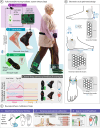Wearable non-invasive neuroprosthesis for targeted sensory restoration in neuropathy
- PMID: 39738088
- PMCID: PMC11686223
- DOI: 10.1038/s41467-024-55152-7
Wearable non-invasive neuroprosthesis for targeted sensory restoration in neuropathy
Abstract
Peripheral neuropathy (PN), the most common complication of diabetes, leads to sensory loss and associated health issues as pain and increased fall risk. However, present treatments do not counteract sensory loss, but only partially manage its consequences. Electrical neural stimulation holds promise to restore sensations, but its efficacy and benefits in PN damaged nerves are yet unknown. We designed a wearable sensory neuroprosthesis (NeuroStep) providing targeted neurostimulation of the undamaged nerve portion and assessed its functionality in 14 PN participants. Our system partially restored lost sensations in all participants through a purposely calibrated neurostimulation, despite PN nerves being less sensitive than healthy nerves (N = 22). Participants improved cadence and functional gait and reported a decrease of neuropathic pain after one day. Restored sensations activated cortical patterns resembling naturally located foot sensations. NeuroStep restores real-time intuitive sensations in PN participants, holding potential to enhance functional and health outcomes while advancing effective non-invasive neuromodulation.
© 2024. The Author(s).
Conflict of interest statement
Competing interests: The authors do not have anything to disclose.
Figures







Similar articles
-
The Effects of a Wearable Sensory Prosthesis on Gait and Balance Function After 10 Weeks of Use in Persons With Peripheral Neuropathy and High Fall Risk - The walk2Wellness Trial.Front Aging Neurosci. 2020 Nov 9;12:592751. doi: 10.3389/fnagi.2020.592751. eCollection 2020. Front Aging Neurosci. 2020. PMID: 33240077 Free PMC article.
-
Neurostimulation techniques for painful peripheral nerve disorders.Neurosurg Clin N Am. 2009 Jan;20(1):111-20, vii-viii. doi: 10.1016/j.nec.2008.07.027. Neurosurg Clin N Am. 2009. PMID: 19064184 Review.
-
Evaluation of transcutaneous electrical nerve stimulation for pain relief in peripheral neuropathy.Phys Ther. 1980 Jan;60(1):48-52. doi: 10.1093/ptj/60.1.48. Phys Ther. 1980. PMID: 6243185 No abstract available.
-
Pulsed magnetic field therapy in refractory neuropathic pain secondary to peripheral neuropathy: electrodiagnostic parameters--pilot study.Neurorehabil Neural Repair. 2004 Mar;18(1):42-6. doi: 10.1177/0888439003261024. Neurorehabil Neural Repair. 2004. PMID: 15035963 Clinical Trial.
-
Peripheral neurostimulation for encoding artificial somatosensations.Eur J Neurosci. 2022 Nov;56(10):5888-5901. doi: 10.1111/ejn.15822. Epub 2022 Sep 25. Eur J Neurosci. 2022. PMID: 36097134 Free PMC article. Review.
Cited by
-
Transcutaneous electrotherapy of facial nerve injuries based on dissolvable conductive microneedles.Bioact Mater. 2025 Jul 28;53:630-640. doi: 10.1016/j.bioactmat.2025.07.013. eCollection 2025 Nov. Bioact Mater. 2025. PMID: 40777562 Free PMC article.
-
Comfort, consistency, and efficiency of garments with textile electrodes versus hydrogel electrodes for neuromuscular electrical stimulation in a randomized crossover trial.Sci Rep. 2025 Feb 26;15(1):6869. doi: 10.1038/s41598-025-91452-8. Sci Rep. 2025. PMID: 40011562 Free PMC article. Clinical Trial.
References
-
- WHO. Global report on diabetes. https://www.who.int/publications-detail-redirect/9789241565257 (2016).
-
- Marx, J. Unraveling the causes of diabetes. Science296, 686–689 (2002). - PubMed
-
- Williams, R. et al. Global and regional estimates and projections of diabetes-related health expenditure: Results from the International Diabetes Federation Diabetes Atlas, 9th edition. Diabetes Res. Clin. Pract.162, 108072 (2020). - PubMed
Publication types
MeSH terms
Grants and funding
- Moveit 197271/Schweizerischer Nationalfonds zur Förderung der Wissenschaftlichen Forschung (Swiss National Science Foundation)
- 320030_175616/Schweizerischer Nationalfonds zur Förderung der Wissenschaftlichen Forschung (Swiss National Science Foundation)
- 759998/EC | EU Framework Programme for Research and Innovation H2020 | H2020 Priority Excellent Science | H2020 European Research Council (H2020 Excellent Science - European Research Council)
LinkOut - more resources
Full Text Sources

